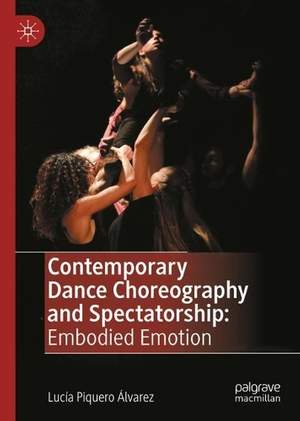
Contemporary Dance Choreography and Spectatorship: Embodied Emotion
- Author: Piquero Álvarez, Lucía
Book
$141.25Special import
Contents
- Chapter 1: Introduction. 4
- The experience of emotional import as complex, bodily and thoughtful 5Understanding emotion. 6
- The affective realm and spectatorship. 9
- Understandings of emotion in dance. 15
- The ‘widely popular doctrine’ 16
- Raw emotion and ineffability. 21
- Emotion in Euro-American contemporary theatre dance. 23
- 4E cognition. 25
- Experience of dance. 28
- Spectator’s experience of Art 29
- Aesthetic experience and disinterest 29
- Kinesthetic empathy. 30
- Establishing the research process. 33
- Case studies. 38
- Content organisation. 41
- How to use the book and web resource. 42
- Chapter 2 The analysis model 44The method of analysis. 45Movement Qualities. 46
- Factors for analysis. 50
- · Weight or Force/Muscular energy. 51
- · Time/bodily rhythm.. 51
- · Kinespheric Space. 52
- · Flow.. 52
- Observing movement qualities/efforts in the case studies. 53
- Spatial-rhythm.. 57
- Spatial forms in the analysis of choreography. 59Virtuality, emergence, and perceptual properties. 60The focal point 66
- Analysis of video based on spatial-rhythm method. 67
- Sound-movement relationships. 69
- Structural relationships between sound and movement 70
- Forms of analysis. 74
- Reviews and my experience. 76
- Video and still frame analysis. 78
- Information from the creative processes. 81
- Selection of examples for discussion. 82
- Chapter 3. Case Study 1: Melancholy Spirals in Russell Maliphant’s Afterlight (Part One) (2009): Emergence, Expressiveness, and Emotional Import 84Introduction to Afterlight (Part One) 85Informed audience perspective. 89Perceptual properties. 90Remarkable
- Emergence. 112
- Expressiveness. 114
- Emotional import 119
- Chapter 4. Case Study 2: The poignant tensions of Crystal Pite’s Dark Matters (2009): Embodiment, Enaction and Emotion. 126Introduction to the work. 127Informed Audience Perspective. 131Perceptual properties. 132Sound/text 133
- Light 136
- Notes on the choreographic process. 137
- Analysis of properties and interactions. 138
- Scene 1 | 00:01 | The solo’s opening scene. 138
- Scene 2 | 01:07 | Power 139
- Scene 3 | 01:33 | Reaching to infinity. 142
- Scene 4 | 01:41-01:54 | Control and vulnerability. 144
- Scene 5 | 02:01- 02:14 | Ripple through the body. 148
- 6 | Words and meaning. 150
- Scene 7 | Final moments. 156
- Chapter insights. 157
- Embodied cognition. 161
- Enactive perception. 164
- Social construction of perception; theatre and visuality. 167
- Embodied Concepts. 169
- Embodiment, enaction and emotion: a summary. 172
- Chapter 5. Case Study 3: the despair of Petrichor (2016): Choreographer, analyst, audience, dancer 174Introduction to Petrichor. 176Informed audience perspective. 180Perceptual Properties. 181Remarkable features: Music. 181Analysis of properties and inter
- The choreographer’s experience. 209
- The dancer’s role. 213
- Chapter 6. Conclusion. 217
- Poignancy as a summarising example. 223Main points for future research. 225Dance analysis. 225
- Other directions of research. 229
- Final thoughts. 232


